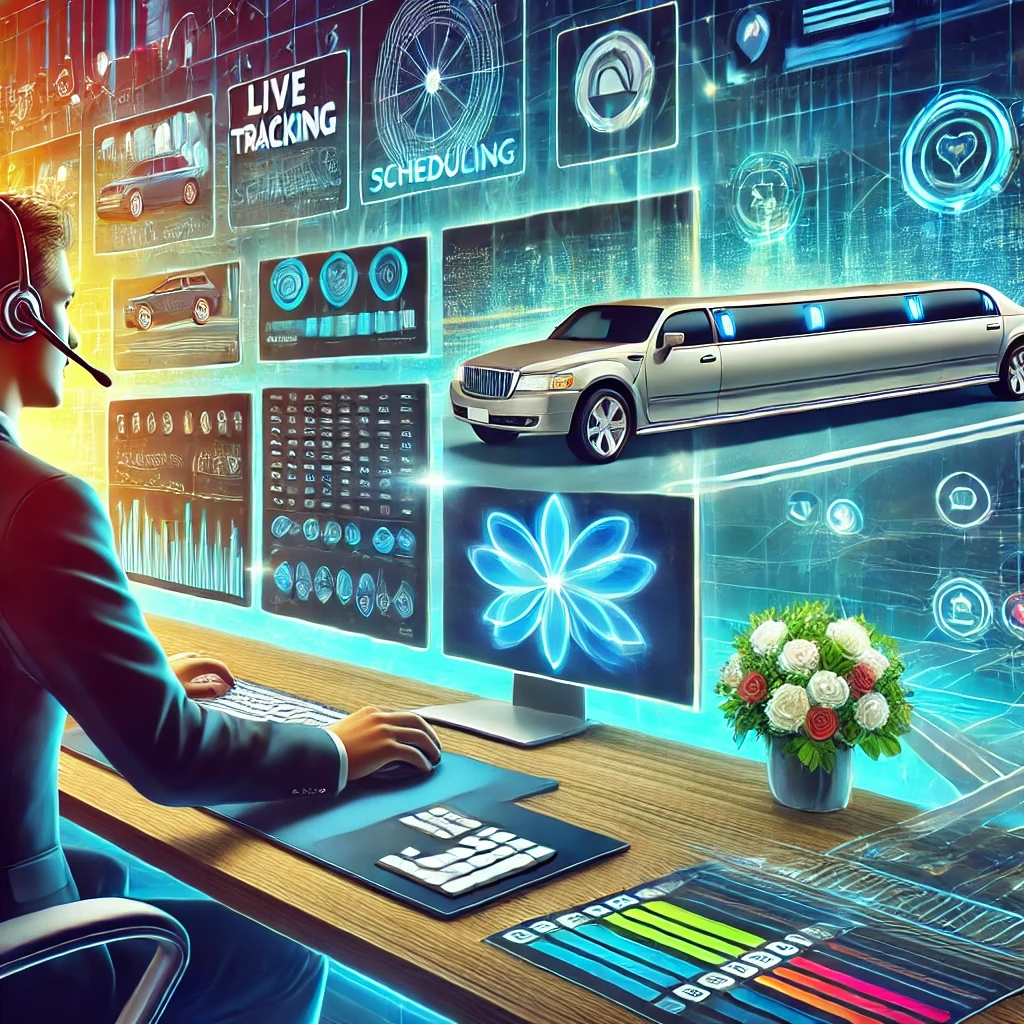The limousine industry has entered a new era, where advances in technology and evolving customer expectations are reshaping dispatch operations. Staying competitive means anticipating the trends that will define the future of dispatch, adapting to new tools, and meeting increasing customer demands. Here, we’ll break down ten significant trends shaping dispatch in the limousine sector, the unique challenges each trend presents, and strategies for effective solutions. From automation to sustainability, this guide will equip you with insights into the industry’s transformation and how to remain agile in a rapidly evolving landscape.
1. Automation in Dispatch: Redefining Efficiency
Issue:
Automation is increasingly integrated into the limousine dispatch industry, promising efficiency and cost-effectiveness. However, adopting automation requires careful planning and resources. Dispatch systems rely on human judgment for complex decisions, and an overreliance on automation may limit this flexibility.
Solution:
To balance efficiency with human oversight, companies can implement hybrid models. This involves using automated dispatch tools for routine scheduling while retaining manual oversight for personalized services and unique requests. Gradual automation adoption allows teams to become familiar with new systems, thereby reducing disruption.
With automated platforms, dispatch teams can focus on high-value tasks, such as customer service and driver management, ultimately leading to a smoother customer experience. The future of dispatch in the limousine industry will increasingly blend human and automated processes, enabling companies to deliver better service at a sustainable cost.
2. Data-Driven Dispatch Decisions: Insights for Success
Issue:
Data analytics are becoming essential in dispatch, but many companies struggle with data interpretation. Knowing which data to prioritize and how to analyze it for actionable insights can be challenging.
Solution:
To overcome this, dispatch teams should focus on key performance indicators (KPIs) like response times, booking rates, and driver efficiency. Limousine companies can leverage platforms that provide real-time data and customizable reports, enabling informed decisions.
Investing in training dispatchers on data interpretation can empower them to use insights for operational improvements. For example, identifying peak booking times can help adjust staffing levels, enhancing service efficiency. Data-driven strategies are vital to the future of dispatch, offering a competitive edge in the limousine industry.
3. Real-Time Tracking and Communication: Meeting Customer Expectations
Issue:
Customers today expect real-time updates about their limousine’s location and estimated arrival times. Yet, implementing real-time tracking involves technical hurdles and significant costs, especially for smaller operators.
Solution:
A practical approach is adopting a GPS-based dispatch system integrated with customer communication tools. This enables dispatchers to share accurate location updates with clients, enhancing transparency and trust. Companies can use affordable third-party GPS solutions to provide a seamless experience without high investment.
Training dispatch teams to proactively communicate any delays or route changes further enhances the client experience. Real-time tracking is a cornerstone of the future of dispatch, as it aligns with customer expectations for convenience and reliability in the limousine industry.
4. Enhanced Driver Management: Ensuring Quality Service
Issue:
Efficient dispatch requires effective driver management, but aligning driver availability with fluctuating demand is a constant challenge. Poor driver allocation can lead to dissatisfied clients and lower service ratings.
Solution:
Using predictive analytics can help anticipate demand spikes and allocate drivers more effectively. Additionally, implementing a feedback loop where drivers can communicate their availability and preferences can lead to a happier, more engaged workforce.
Regular training on new dispatch systems can help drivers understand the system’s value in optimizing their schedules, which improves the overall service experience. The future of dispatch will prioritize a collaborative approach to driver management, ensuring customer satisfaction and driver retention.
5. Mobile-First Dispatch Solutions: Increasing Accessibility
Issue:
Dispatch operations need mobile accessibility to keep up with an increasingly mobile workforce. However, many limousine companies face technical constraints in implementing mobile solutions seamlessly.
Solution:
Mobile-friendly dispatch software can be a game-changer, allowing dispatchers and drivers to manage bookings on the go. These solutions should be easy to navigate, with key features like booking management, GPS integration, and communication tools readily accessible on mobile devices.
Implementing a mobile-first approach ensures that dispatch teams can respond swiftly to requests, whether in the office or in the field. As mobile access becomes the norm, the future of dispatch in the limousine industry will hinge on solutions that enable mobility and connectivity.
6. Customer-Centric Dispatch Models: Personalized Service at Scale
Issue:
Balancing personalization with efficiency is challenging, especially for larger operators handling high booking volumes. Standard dispatch models may fall short of meeting individual client preferences.
Solution:
Integrating customer profiles into dispatch systems can allow for personalized service at scale. Details such as preferred drivers, routes, and amenities can be stored and retrieved for each booking, ensuring each client enjoys a tailored experience.
Personalization strengthens customer loyalty and sets limousine services apart from more standardized options. The future of dispatch will lean toward a customer-centric approach, where service is consistently personalized, building a lasting bond with clients.
7. Sustainability in Dispatch: Greener Practices
Issue:
The limousine industry faces increasing pressure to adopt environmentally friendly practices. Implementing green initiatives in dispatch, however, can be costly and challenging to monitor.
Solution:
Adopting eco-friendly dispatch policies, such as optimizing routes for fuel efficiency and incorporating hybrid or electric vehicles, can make a significant impact. Dispatch systems can include fuel-efficiency metrics to monitor progress and highlight areas for improvement.
Many customers appreciate eco-conscious services, giving companies that prioritize sustainability a competitive edge. In the future of dispatch, greener practices will not only meet regulatory standards but also resonate with environmentally aware clients.
8. AI and Predictive Analytics: Anticipating Needs and Demand
Issue:
AI offers vast potential in dispatch, but the implementation process can be complex and costly. For smaller companies, integrating AI can seem daunting.
Solution:
Starting with predictive analytics tools is an affordable entry point into AI-powered dispatch. These tools can forecast peak times, allowing dispatchers to allocate resources more efficiently. As teams grow comfortable with data-driven insights, they can gradually adopt more advanced AI solutions for automated scheduling and customer preferences.
AI in the future of dispatch will enable limousine companies to stay one step ahead, offering a proactive service model that appeals to high-end clients expecting a seamless experience.
9. Safety and Compliance in Dispatch Operations
Issue:
Safety and compliance are critical but challenging to maintain, especially with shifting regulations and diverse client requirements.
Solution:
Dispatch solutions with built-in compliance features can ease the burden. For instance, systems that automatically track driver hours and alert teams when regulatory thresholds are met ensure that limousine companies remain compliant.
Educating dispatch teams on compliance protocols and implementing real-time monitoring helps reduce risks and protect both passengers and drivers. The future of dispatch will increasingly focus on streamlined safety management, ensuring trust and peace of mind for clients.
10. Integrated Customer Support in Dispatch: Elevating the Experience
Issue:
Dispatch operations and customer support often operate independently, which can create communication gaps and impact customer satisfaction.
Solution:
Integrating customer support into dispatch can provide a seamless client experience, allowing for instant responses to queries and real-time updates. Platforms that combine dispatch and support enable teams to collaborate effectively, addressing client needs quickly and efficiently.
This unified approach will be essential in the future of dispatch, offering a smooth, connected experience that enhances client satisfaction and loyalty in the limousine industry.
Conclusion: Preparing for the Future of Dispatch
The future of dispatch in the limousine industry is set for transformation. Embracing these trends ensures that limousine companies are prepared to meet client expectations while maintaining efficiency. As the industry grows, companies that leverage automation, prioritize sustainability, and adopt customer-centric practices will lead the way.
For businesses seeking a reliable dispatch and customer support service, Saztech Solutions offers expert services designed to meet the demands of a dynamic industry. Discover how our team can elevate your limousine company’s dispatch operations by visiting our website at Saztech Solutions.
Home | About Us | Pricing | Get Started | FAQ | Dispatch Daily | Contact Us
WhatsApp | Facebook | LinkedIn





Leave a Reply